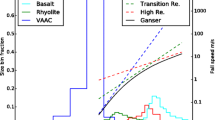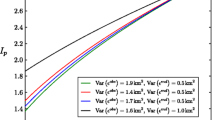Abstract
Data on source conditions for the 14 April 2010 paroxysmal phase of the Eyjafjallajökull eruption, Iceland, have been used as inputs to a trajectory-based eruption column model, bent. This model has in turn been adapted to generate output suitable as input to the volcanic ash transport and dispersal model, puff, which was used to propagate the paroxysmal ash cloud toward and over Europe over the following days. Some of the source parameters, specifically vent radius, vent source velocity, mean grain size of ejecta, and standard deviation of ejecta grain size have been assigned probability distributions based on our lack of knowledge of exact conditions at the source. These probability distributions for the input variables have been sampled in a Monte Carlo fashion using a technique that yields what we herein call the polynomial chaos quadrature weighted estimate (PCQWE) of output parameters from the ash transport and dispersal model. The advantage of PCQWE over Monte Carlo is that since it intelligently samples the input parameter space, fewer model runs are needed to yield estimates of moments and probabilities for the output variables. At each of these sample points for the input variables, a model run is performed. Output moments and probabilities are then computed by properly summing the weighted values of the output parameters of interest. Use of a computational eruption column model coupled with known weather conditions as given by radiosonde data gathered near the vent allows us to estimate that initial mass eruption rate on 14 April 2010 may have been as high as 108 kg/s and was almost certainly above 107 kg/s. This estimate is consistent with the probabilistic envelope computed by PCQWE for the downwind plume. The results furthermore show that statistical moments and probabilities can be computed in a reasonable time by using 94 = 6,561 PCQWE model runs as opposed to millions of model runs that might be required by standard Monte Carlo techniques. The output mean ash cloud height plus three standard deviations—encompassing c. 99.7 % of the probability mass—compares well with four-dimensional ash cloud position as retrieved from Meteosat-9 SEVIRI data for 16 April 2010 as the ash cloud drifted over north-central Europe. Finally, the ability to compute statistical moments and probabilities may allow for the better separation of science and decision-making, by making it possible for scientists to better focus on error reduction and decision makers to focus on “drawing the line” for risk assessment.












Similar content being viewed by others
References
Adler RJ (1981) The geometry of random fields. Wiley, London
Augusti G, Baratta A, Casciati F (1984) Probabilistic methods in structural engineering. Chapman and Hall, London
Ben-Haim Y, Elishakoff I (1990) Convex models of uncertainty in applied mechanics. Elsevier, Amsterdam
Berveiller M, Sudret B, Lemaire M (2006) Stochastic finite element: a non intrusive approach by regression. Rev Eur Mec Numer 15:81–92
Bonadonna C, Folch A, Loughlin S, Puempel H (2010) Ash dispersal forecast and civil aviation workshop, Geneva, Switzerland, 18–20 October 2010: Consensual document. Web document, World Meteorological Organization, Geneva, Switzerland. Available via Vhub. http://vhub.org/resources/503. Accessed 1 Oct 2012
Bursik M (2001) Effect of wind on the rise height of volcanic plumes. Geophys Res Lett 18:3621–3624
Bursik M, Kobs S, Burns A, Braitseva O, Bazanova L, Melekestsev I, Kurbatov A, Pieri D (2009) Volcanic plumes and the wind: jetstream interaction examples and implications for air traffic. J Volcanol Geotherm Res 186:60–67
Calder E, Sparks R, Woods A (1997) Dynamics of co-ignimbrite plumes generated from pyroclastic flows of Mount St. Helens (7 August 1980). Bull Volcanol 58:432–440
Cheney EW, Kincaid D (1999) Numerical mathematics and computing. Brooks/Cole, Pacific Grove
Chouet B, Hamiseviez N, McGetchin T (1974) Photoballistics of volcanic jet activity at Stromboli, Italy. J Geophys Res 79:4961–4976
Christakos G (1992) Random field models in earth sciences. Academic, San Diego
Clenshaw CW, Curtis AR (1960) A method for numerical integration on an automatic computer. Numer Math 2:197–205
Dalbey K, Patra A, Pitman E, Bursik M, Sheridan M (2008) Input uncertainty propagation methods and hazard mapping of geophysical mass flows. J Geophys Res 113:B05203. doi:10.1029/2006JB004471
Elishakoff I (1999) Whys and hows in uncertainty modelling probability, fuzziness, and anti-optimization. Springer, Berlin
Folch A (2012) A review of tephra transport and dispersal models: evolution, current status, and future perspectives. J Volcanol Geotherm Res 235–236:96–115. doi:10.1016/j.jvolgeores.2012.05.020
Folk RL, Ward WC (1957) Brazos River bar, a study in the significance of grain size parameters. J Sediment Petrol 27:3–27
Glaze L, Baloga S, Wilson L (1997) Transport of atmospheric water vapour by volcanic eruption columns. J Geophys Res 102:6099–6108
Graf HF, Herzog M, Oberhuber JM, Textor C (1999) Effect of environmental conditions on volcanic plume rise. J Geophys Res 104:24,309–24,320
Grigoriu M (2002) Stochastic calculus applications in science and engineering. Birkhauser, Basel
Heidinger AK, Pavolonis MJ (2009) Nearly 30 years of gazing at cirrus clouds through a split-window. Part I: methodology. J Appl Meteorol Climatol 48:1110–1116
Heidinger AK, Pavolonis MJ, Holz RE, Baum BA, Berthier S (2010) Using calipso to explore the sensitivity to cirrus height in the infrared observations from npoess/viirs and goes-r/abi. J Geophys Res 115. doi:10.1029/2009JD012152
Keiding JK, Sigmarsson O (2012) Geothermobarometry of the 2010 Eyjafjallajokull eruption: new constraints on Icelandic magma plumbing systems. J Geophys Res 117:B00C09. doi:10.1029/2011JB008829
LeMaitre O, Knio O, Najm H, Ghanem R (2001) A stochastic projection method for fluid flow: I. Basic formulation. J Comput Phys 173:481–511
Mastin LG (2007) A user-friendly one-dimensional model for wet volcanic plumes. Geochem Geophys Geosyst 8:014
Mastin L, Guffanti M, Servanckx R, Webley P, Barostti S, Dean K, Denlinger R, Durant A, Ewert J, Gardner C, Holliday A, Neri A, Rose W, Schneider D, Siebert L, Stunder B, Swanson G, Tupper A, Volentik A, Waythomas A (2009) A multidisciplinary effort to assign realistic source parameters to models of volcanic ash-cloud transport and dispersion during eruptions. J Volcanol Geotherm Res 186:10–21, special issue on Volcanic Ash Clouds; L. Mastin and P.W. Webley (eds.)
Morton B, Taylor G, Turner J (1956) Gravitational turbulent convection from maintained and instantaneous sources. Proc R Soc Lond A 234:1–23
Natke HG, Ben-Haim Y (1997) Uncertainty: models and measures. Akademie, Berlin
NCEP (2009a) National Center for Environmental Prediction: Unidata online access to the operational Global Forecasting System (GFS) numerical weather prediction model. http://motherlode.ucar.edu:8080/thredds/catalog/fmrc/NCEP/GFS/Global_0p5deg/catalog.html
NCEP (2009b) National Center for Environmental Prediction: Unidata online access to the operational North American Mesoscale (NAM) numerical weather prediction model. http://motherlode.ucar.edu:8080/thredds/catalog/fmrc/NCEP/NAM/Alaska_11km/catalog.html
Papoulis A (1984) Probability, random variables, and stochastic processes. McGraw-Hill, New York
Pavolonis MJ (2010) Advances in extracting cloud composition information from spaceborne infrared radiances: a robust alternative to brightness temperatures. Part I: theory. J Appl Meteorol Climatol 49:1992–2012
Pavolonis MJ, Feltz WF, Heidinger AK, Gallina GM (2006) A daytime complement to the reverse absorption technique for improved automated detection of volcanic ash. J Atmos Ocean Technol 23:1422–1444
Petersen GN (2010) A short meteorological overview of the Eyjafjallajökull eruption 14 April–23 May 2010. Weather 65:203–207
Ryall DB, Maryon RH (1998) Validation of the uk met. office name model against the etex dataset. Atmos Environ 32:4265–4276
Scollo S, Prestilippo M, Coltelli M, Peterson R, Spata G (2011) A statistical approach to evaluate the tephra deposit and ash concentration from PUFF model forecasts. J Volcanol Geotherm Res 200:129–142
Searcy C, Dean K, Stringer B (1998) PUFF: a high-resolution volcanic ash tracking model. J Volcanol Geotherm Res 80:1–16
Shafer G (1976) A mathematical theory of evidence. Princeton University Press, Princeton
Sparks R, Wilson L (1982) Explosive volcanic eruptions—V. Observations of plume dynamics during the 1979 Soufriere eruption, St. Vincent. Geophys J Roy Astron Soc 69:551–570
Sparks RSJ, Bursik MI, Carey SN, Gilbert JS, Glaze LS, Sigurdsson H, Woods AW (1997) Volcanic plumes. Wiley, London, p 574
Textor C, Graf H, Herzog M, Oberhuber J, Rose WI, Ernst G (2006) Volcanic particle aggregation in explosive eruption columns. Part II: numerical experiments. J Volcanol Geotherm Res 150:378–394
Thorkelsson B (2012) The 2010 eruption of Eyjafjallajokull, Iceland. Tech. rep., Icelandic Meteorological Office, http://jardvis.hi.is/sites/default/files/Pdf_skjol/Eyjafjallajokull_2010/icaoreport_web.pdf, retrieved Sept 2012
Torquato S (2002) Random heterogeneous materials. Springer, Berlin
Tupper A, Textor C, Herzog M, Graf HF, Richards MS (2009) Tall clouds from small eruptions: the sensitivity of eruption height and fine ash content to tropospheric instability. Nat Hazard 51:375–401. doi:10.1007/s11069-009-9433-9
USN-FNMOC (2009) U.S. Navy Fleet Numerical Meteorology and Oceanography Center: Online access to the Navy Operational Global Atmospheric Prediction System numerical weather prediction model (NOGAPS). http://www.usno.navy.mil/FNMOC/
Wen S, Rose WI (1994) Retrieval of sizes and total masses of particles in volcanic ash clouds using avhrr bands 4 and 5. J Geophys Res 99:5421–5431
Wiener N (1938) The homogeneous chaos. Am J Math 60(4):897–936
Woods AW (1993) Moist convection and the injection of volcanic ash into the atmosphere. J Geophys Res 98:17,627–17,636
Woods A, Bursik M (1991) Particle fallout, thermal disequilibrium and volcanic plumes. Bull Volcanol 53:559–570
WRF (2009) Online access to the Weather Research and Forecasting Model. http://www.wrf-model.org/index.php
Xiu D, Hesthaven J (2005) High-order collocation methods for differential equations with random inputs. SIAM J Sci Comput 27:1118–1139
Xiu D, Karniadakis GE (2002) The Wiener–Askey polynomial chaos for stochastic differential equations. SIAM J Sci Comput 24(2):619–644. doi:10.1137/S1064827501387826
Acknowledgments
This material is based upon work supported by the National Science Foundation under grant no. EAR-1041775. The manuscript was completed under funding from AFOSR and an NSF-IDR grant. Any opinions, findings, and conclusions or recommendations expressed in this material are those of the author(s) and do not necessarily reflect the views of the National Science Foundation. Fred Prata, Armann Hoskuldsson, Thorvaldur Thordarson, and other researchers at several meetings generously discussed their own results with the authors. We thank AE M. Manga, an anonymous reviewer and C. Bonadonna for helpful, constructive criticisms of the manuscript.
Author information
Authors and Affiliations
Corresponding author
Additional information
Editorial responsibility: M. Manga
Electronic supplementary material
Below is the link to the electronic supplementary material.
ESM 1
(PDF 39 kb)
Rights and permissions
About this article
Cite this article
Bursik, M., Jones, M., Carn, S. et al. Estimation and propagation of volcanic source parameter uncertainty in an ash transport and dispersal model: application to the Eyjafjallajokull plume of 14–16 April 2010. Bull Volcanol 74, 2321–2338 (2012). https://doi.org/10.1007/s00445-012-0665-2
Received:
Accepted:
Published:
Issue Date:
DOI: https://doi.org/10.1007/s00445-012-0665-2




